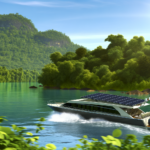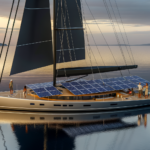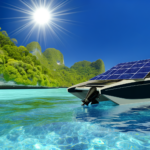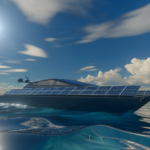Introduction to Eco-Friendly Boating
The Importance of Sustainability on the Water
Sustainability is a critical concern for modern boaters, as traditional fuel sources like gasoline and diesel contribute significantly to environmental degradation. The emissions from these fuels not only pollute the air but also harm marine ecosystems, which are particularly sensitive to pollutants. Moreover, the noise from fuel-powered engines disrupts aquatic life, affecting everything from fish to marine mammals. By adopting eco-friendly boating practices, we can help preserve these delicate ecosystems for future generations.
Benefits of Solar Power for Boaters
Switching to solar power offers numerous advantages for boaters. Here are some key benefits:
- Energy Independence: Solar power allows boaters to generate their own electricity, reducing reliance on shore power or fuel-powered generators. This is particularly beneficial for those who enjoy exploring remote locations.
- Cost Savings: Once installed, solar panels provide free electricity, significantly lowering energy costs over time. This can be a substantial saving, especially for long-term or frequent boaters.
- Environmental Impact: Solar energy is a clean, renewable resource that produces zero emissions. By using solar power, boaters can reduce their carbon footprint and contribute to a healthier planet.
- Quiet Operation: Unlike noisy generators, solar panels operate silently, allowing for a more peaceful and enjoyable boating experience.
- Low Maintenance: Solar panels have no moving parts, which means they require minimal maintenance compared to traditional generators. This translates to fewer repairs and longer-lasting equipment.
Overview of Solar Kits for Boating
Solar kits for boats are designed to provide a comprehensive solution for harnessing solar energy on the water. These kits typically include high-efficiency solar panels, inverters, charge controllers, mounting hardware, and optional battery storage. Here’s a brief overview of what you can expect from a solar kit:
- High-Efficiency Solar Panels: These panels are designed to capture maximum sunlight, even in low-light or cloudy conditions, ensuring reliable power generation.
- Inverters: Inverters convert the Direct Current (DC) produced by the solar panels into Alternating Current (AC), which is compatible with most onboard appliances and electronics.
- Charge Controllers: These devices regulate the flow of electricity from the solar panels to the batteries, preventing overcharging and optimizing battery life.
- Mounting Hardware: Kits include all necessary hardware for securely mounting the solar panels to your boat.
- Optional Battery Storage: Some kits come with lithium-ion batteries for storing excess energy, allowing you to use solar power even at night or during periods of low sunlight.
In summary, solar kits offer a practical and eco-friendly solution for boaters looking to achieve energy independence while reducing their environmental impact. By investing in a solar kit, you can enjoy the freedom of off-grid boating, significant cost savings, and the satisfaction of contributing to a greener planet.
Understanding Solar Power for Boats
How Solar Power Works
Solar power harnesses the energy from the sun and converts it into electricity, providing a renewable and sustainable power source. The process begins with solar panels, which are composed of photovoltaic (PV) cells. These cells absorb sunlight and generate direct current (DC) electricity through the photovoltaic effect. The DC electricity is then converted into alternating current (AC) by an inverter, making it suitable for powering various onboard appliances and systems.
The efficiency of solar power generation depends on several factors, including the type of solar panels used, their placement, and the amount of sunlight they receive. For boaters, this means strategically positioning the panels to maximize sun exposure and ensuring they are free from obstructions like sails or antennas.
Components of a Solar Kit
A complete solar kit for boats typically includes several key components:
- Solar Panels: These are the primary components that capture sunlight and convert it into electricity. They come in various types and sizes, each with different efficiency levels and installation requirements.
- Inverter: This device converts the DC electricity generated by the solar panels into AC electricity, which is used by most onboard appliances.
- Charge Controller: This component regulates the voltage and current coming from the solar panels to the batteries, preventing overcharging and ensuring optimal battery performance.
- Batteries: These store the electricity generated by the solar panels, allowing you to use solar power even when the sun is not shining.
- Mounting Hardware: This includes brackets, screws, and other materials needed to securely attach the solar panels to your boat.
- Wiring and Connectors: These are essential for connecting all the components of the solar kit and ensuring a reliable flow of electricity.
Types of Solar Panels Suitable for Boats
When selecting solar panels for your boat, it’s important to consider the different types available and their respective advantages and disadvantages:
- Monocrystalline Panels: These panels are made from single-crystal silicon and are known for their high efficiency and durability. They perform well in low-light conditions and have a long lifespan, making them a popular choice for boaters. However, they tend to be more expensive than other types.
- Polycrystalline Panels: Made from multiple silicon crystals, these panels are slightly less efficient than monocrystalline panels but are more affordable. They have a shorter lifespan and are less effective in low-light conditions, but they still offer a good balance of performance and cost.
- Amorphous (Thin-Film) Panels: These panels are made by placing a thin layer of silicon on a flexible backing, making them lightweight and versatile. They are less efficient than crystalline panels but perform better in shaded conditions. Their flexibility allows them to be installed on curved surfaces, which is ideal for boats with limited flat space.
Each type of panel has its own set of benefits and trade-offs, so it’s important to assess your specific needs and conditions when choosing the right solar panels for your boat. By understanding how solar power works and the components involved, you can make an informed decision and enjoy the benefits of clean, renewable energy on the water.
Choosing the Right Solar Kit for Your Boat
Assessing Your Energy Needs
Before selecting a solar kit for your boat, it is crucial to assess your energy needs. Start by listing all the electrical devices and appliances you plan to power with solar energy. This list might include navigation systems, lights, refrigerators, communication devices, and entertainment systems. Calculate the total wattage required by each device and estimate the daily usage in hours. Multiply the wattage by the hours of use to get the total watt-hours needed per day.
For example, if you have a 50-watt refrigerator running for 10 hours a day, it will consume 500 watt-hours daily. Summing up the watt-hours for all devices will give you a clear picture of your total energy consumption. This calculation will help you determine the size and capacity of the solar kit you need to meet your energy demands efficiently.
Factors to Consider: Size, Weight, and Efficiency
When choosing a solar kit for your boat, several factors must be considered to ensure optimal performance and practicality:
- Size: The available space on your boat will dictate the size of the solar panels you can install. Measure the dimensions of potential installation areas, such as the deck, cabin roof, or bimini top, to ensure the panels fit without obstructing movement or other equipment.
- Weight: The weight of the solar panels and associated components is another critical factor, especially for smaller boats. Heavier panels may affect the boat’s balance and performance. Opt for lightweight, flexible panels if weight is a concern.
- Efficiency: Solar panel efficiency determines how much sunlight is converted into usable electricity. Monocrystalline panels are typically more efficient and space-saving compared to polycrystalline panels. Higher efficiency panels may cost more but can generate more power in limited space.
Additionally, consider the durability and weather resistance of the panels. Marine environments can be harsh, with exposure to saltwater, UV rays, and varying weather conditions. Ensure the panels are designed to withstand these elements, with a high Ingress Protection (IP) rating, preferably IP67 or higher.
Installation Considerations
Proper installation is key to maximizing the performance and longevity of your solar kit. Here are some installation considerations to keep in mind:
- Mounting Options: Solar panels can be mounted in various ways, including fixed mounts, adjustable mounts, and flexible mounts. Fixed mounts are sturdy and secure but may not allow for optimal sun exposure throughout the day. Adjustable mounts can be tilted to capture maximum sunlight, while flexible mounts can conform to curved surfaces, providing more installation options.
- Wiring and Connections: Ensure that the wiring and connections are suitable for marine environments. Use marine-grade cables and connectors to prevent corrosion and ensure reliable performance. Properly seal all connections to protect against water ingress.
- Charge Controllers and Inverters: A charge controller is essential to regulate the flow of electricity from the solar panels to the battery, preventing overcharging and extending battery life. Choose a charge controller compatible with your solar panel’s output and battery type. If you plan to use AC appliances, an inverter will be necessary to convert DC power from the battery to AC power.
- Battery Storage: Consider the type and capacity of the battery bank to store the solar energy. Deep cycle marine batteries are commonly used for their ability to handle repeated charging and discharging cycles. Ensure the battery capacity matches your energy consumption needs.
By carefully assessing your energy needs, considering size, weight, and efficiency, and planning the installation, you can choose the right solar kit to achieve energy independence on the water.
Top Solar Kits for Energy Independence
High-Efficiency Solar Kits
High-efficiency solar kits are designed to maximize energy production, even in less-than-ideal conditions. These kits typically feature monocrystalline solar panels, which are known for their high efficiency and superior performance in low-light environments. One standout option in this category is the **Renogy 175W 12V Monocrystalline Solar Panel**. This panel boasts a multi-layered lamination that enhances cell performance and ensures a long service life. It also includes bypass diodes to minimize power drops caused by shade and overcast weather, making it a reliable choice for marine environments.
Another excellent high-efficiency option is the **SOLPERK 50W Solar Panel Kit**. Despite its lower wattage, it offers an elevated conversion efficiency of up to 24%, thanks to its high-quality monocrystalline cells. The panel is made of durable tempered glass and weatherproof film encapsulated in an aluminum frame, ensuring it can withstand harsh marine conditions. This kit is versatile and can be used to charge a variety of 12V DC batteries, making it ideal for different types of boats.
Portable Solar Kits
Portable solar kits are perfect for boaters who need a flexible and easy-to-install solution. These kits are designed to be lightweight and compact, making them easy to transport and set up. The **SUNER POWER 12V Solar Battery Charger** is a top choice in this category. This portable charger is highly durable, featuring a waterproof solar glass and an upgraded ABS frame. It is designed to safely charge and maintain various types of batteries, including Wet, Gel, SLA, AGM, and Deep Cycle batteries. Its built-in blocking diode prevents reverse discharges, ensuring your battery remains protected.
Another great portable option is the **Sunway Solar Battery Charger**. This compact panel can be easily mounted on the windshield or dashboard of your boat. It features built-in diodes to manage battery drain and prevent overheating, making it a safe and reliable choice. The panel is covered with clear PV glass and housed in rugged ABS plastic, enhancing its durability and resistance to the elements.
Budget-Friendly Solar Kits
For those looking to go solar without breaking the bank, budget-friendly solar kits offer a cost-effective solution. The **SUNER POWER 12V Solar Battery Charger** is not only portable but also highly affordable, making it an excellent choice for budget-conscious boaters. Despite its low price, it offers a compact, durable design and adequate energy conversion rates, ensuring you get good value for your money.
Another budget-friendly option is the **RICH SOLAR 2 Pieces 100W 12V Polycrystalline Solar Panel**. This kit includes two panels that can generate up to 10.8 amps of power, making it a powerful yet affordable choice. The panels are designed to perform well in low-light conditions and are built to withstand harsh marine environments. They come with pre-drilled holes for easy installation, making them a convenient and cost-effective option for boaters.
In summary, whether you prioritize efficiency, portability, or affordability, there are solar kits available to meet your specific needs. High-efficiency kits like the Renogy 175W and SOLPERK 50W offer superior performance, while portable options like the SUNER POWER and Sunway Solar Battery Charger provide flexibility and ease of use. For those on a budget, the SUNER POWER and RICH SOLAR kits offer excellent value without compromising on quality.
Installation and Maintenance of Solar Kits
Step-by-Step Installation Guide
Installing a solar kit on your boat can seem daunting, but with the right approach, it can be a straightforward process. Here’s a step-by-step guide to help you get started:
1. **Assess Your Boat’s Layout**: Identify the best location for your solar panels. This should be an area that receives maximum sunlight and is free from obstructions and shadows.
2. **Gather Tools and Materials**: Ensure you have all necessary tools, including a drill, screws, mounting brackets, and wiring. Most solar kits come with a detailed list of required tools.
3. **Mount the Solar Panels**: Use the provided mounting brackets to secure the panels. For rigid panels, mount them on a flat surface using screws. For flexible panels, use adhesive or screws as per the manufacturer’s instructions.
4. **Install the Charge Controller**: The charge controller regulates the voltage and current from the solar panels to the battery. Mount it in a dry, accessible location.
5. **Connect the Wiring**: Connect the solar panels to the charge controller using the provided cables. Ensure all connections are secure and waterproof.
6. **Connect to the Battery**: Finally, connect the charge controller to your boat’s battery. Double-check all connections to ensure they are correct and secure.
7. **Test the System**: Once everything is connected, test the system to ensure it is working correctly. Check the charge controller display to confirm that the panels are generating power and charging the battery.
Maintenance Tips for Longevity
Proper maintenance is crucial to ensure the longevity and efficiency of your solar kit. Here are some tips to keep your system in top shape:
– **Regular Cleaning**: Clean the solar panels regularly to remove dirt, salt, and bird droppings. Use a soft cloth and mild detergent to avoid scratching the surface.
– **Inspect Connections**: Periodically check all electrical connections for signs of corrosion or wear. Tighten any loose connections and replace any damaged cables.
– **Monitor Performance**: Keep an eye on the charge controller’s display to monitor the system’s performance. Any significant drop in power output could indicate a problem.
– **Check for Damage**: Inspect the panels and mounting hardware for any signs of physical damage, especially after severe weather. Replace any damaged components immediately.
– **Battery Maintenance**: If you’re using lead-acid batteries, check the electrolyte levels regularly and top up with distilled water as needed. For lithium batteries, ensure they are kept within the recommended temperature range.
Troubleshooting Common Issues
Even with proper maintenance, you may encounter some issues with your solar kit. Here are some common problems and their solutions:
– **Low Power Output**: If your panels are not generating enough power, check for shading, dirt, or damage on the panels. Ensure all connections are secure and the charge controller is functioning correctly.
– **Battery Not Charging**: If the battery isn’t charging, check the connections between the charge controller and the battery. Ensure the charge controller settings are correct for your battery type.
– **Overcharging**: If the battery is overcharging, the charge controller may be faulty. Check the controller settings and replace it if necessary.
– **Inconsistent Performance**: If the system’s performance is inconsistent, check for loose or corroded connections. Ensure the panels are securely mounted and not moving or vibrating excessively.
By following these installation and maintenance tips, you can ensure that your solar kit provides reliable and efficient power for your boating adventures.
Maximizing the Efficiency of Your Solar Kit
Optimal Placement of Solar Panels
The placement of your solar panels is crucial for maximizing their efficiency. **Optimal placement** ensures that your panels receive the maximum amount of sunlight throughout the day. Here are some tips to achieve this:
- Orientation: Position your panels to face the sun directly. In the Northern Hemisphere, this typically means facing them south. Adjust the angle based on your latitude to capture the most sunlight.
- Avoid Shading: Ensure that your panels are not shaded by masts, sails, or other structures on your boat. Even partial shading can significantly reduce the efficiency of your solar panels.
- Use Adjustable Mounts: Consider using adjustable mounts that allow you to change the angle of your panels as the sun moves across the sky. This can help you capture more sunlight throughout the day.
- Flexible Panels: For boats with limited space, flexible solar panels can be a great option. They can be mounted on curved surfaces and are less likely to be shaded.
Energy Storage Solutions
Storing the energy generated by your solar panels is essential for ensuring a reliable power supply, especially during cloudy days or at night. Here are some **energy storage solutions** to consider:
- Lithium-Ion Batteries: These batteries are lightweight, have a high energy density, and a longer lifespan compared to traditional lead-acid batteries. They are ideal for marine environments due to their durability and efficiency.
- Battery Management Systems (BMS): A BMS is crucial for monitoring and managing the health of your batteries. It helps prevent overcharging, over-discharging, and ensures optimal performance.
- Charge Controllers: These devices regulate the flow of electricity from the solar panels to the batteries, preventing overcharging and ensuring efficient energy storage. MPPT (Maximum Power Point Tracking) charge controllers are highly recommended for their efficiency.
- Energy Storage Capacity: Assess your energy needs and choose a battery system with sufficient capacity to store the energy you generate. This ensures you have enough power during periods of low sunlight.
Monitoring and Managing Energy Use
Effective monitoring and management of your energy use can significantly enhance the efficiency of your solar kit. Here are some strategies to help you **monitor and manage** your energy consumption:
- Energy Monitors: Install energy monitors to keep track of your energy production and consumption in real-time. This helps you understand your energy usage patterns and make informed decisions.
- Smart Inverters: Use smart inverters that can provide detailed information about your solar system’s performance. They can also help optimize energy conversion and reduce losses.
- Energy-Efficient Appliances: Invest in energy-efficient appliances and LED lighting to reduce your overall energy consumption. This allows you to make the most of the energy generated by your solar panels.
- Behavioral Adjustments: Be mindful of your energy use. Simple actions like turning off lights and appliances when not in use can make a significant difference in your overall energy consumption.
- Regular Maintenance: Keep your solar panels clean and free of debris to ensure they operate at peak efficiency. Regularly check your batteries and other components to ensure they are in good working condition.
By following these guidelines, you can maximize the efficiency of your solar kit, ensuring a reliable and sustainable power supply for your boating adventures.
Conclusion and Future Trends
Summary of Benefits
Eco-friendly boating, particularly through the use of solar power, offers a multitude of benefits that extend beyond the immediate advantages of reduced fuel costs and quieter operation. **Solar-powered boats** are a significant step towards sustainability, as they emit zero greenhouse gases, thereby contributing to the fight against climate change. Additionally, they are independent of fossil fuels, which are finite and increasingly expensive. This independence not only ensures a more resilient energy source but also reduces the risk of fuel spills and fires, enhancing safety on the water.
Moreover, solar-powered boats require less maintenance due to their simpler machinery and fewer moving parts. This translates to lower long-term costs and easier upkeep. The quiet operation of electric motors also provides a more serene boating experience, free from the noise pollution associated with traditional engines. Collectively, these benefits make solar-powered boats an attractive option for both recreational and commercial use, promoting a greener, quieter, and safer boating environment.
Emerging Technologies in Solar Power
The future of solar-powered boating is bright, with several emerging technologies poised to enhance efficiency and usability. **Improved solar panel efficiency** is at the forefront, with ongoing research aimed at developing photovoltaic cells that can generate more electricity from the same amount of sunlight. This will allow boats to harness more energy, increasing their range and operational capabilities.
**Energy storage technology** is another critical area of advancement. The development of more efficient and lightweight batteries with higher energy densities will enable boats to store larger amounts of solar-generated energy. This will extend their operational range and allow for continuous use even during periods of low sunlight.
Additionally, the integration of **smart energy management systems** will optimize the use of solar power on boats. These systems can dynamically allocate energy based on real-time conditions, such as solar irradiation and battery charge levels, ensuring optimal performance. The combination of solar power with other renewable energy sources, such as wind or hydrogen fuel cells, is also being explored to further enhance efficiency and range.
**Lightweight materials and innovative boat designs** will play a crucial role in maximizing energy efficiency. Advanced composite materials and hydrodynamic designs can reduce drag and improve overall performance, making solar-powered boats more viable for a wider range of applications.
Final Thoughts on Eco-Friendly Boating
The transition to eco-friendly boating, particularly through the adoption of solar power, represents a significant shift towards sustainability in the maritime industry. As technology continues to advance, the barriers to widespread adoption are gradually being overcome, making solar-powered boats an increasingly practical and attractive option.
The benefits of solar-powered boating are clear: reduced environmental impact, lower operational costs, and enhanced safety and serenity on the water. As we look to the future, the integration of emerging technologies will only amplify these advantages, paving the way for a new era of sustainable boating.
In conclusion, eco-friendly boating is not just a trend but a necessary evolution in response to the pressing environmental challenges we face. By embracing solar power and other renewable energy sources, we can ensure that our waterways remain clean and vibrant for future generations. The journey towards energy independence on the water is well underway, and the future holds exciting possibilities for those willing to navigate this sustainable path.






